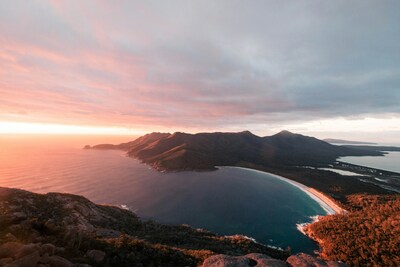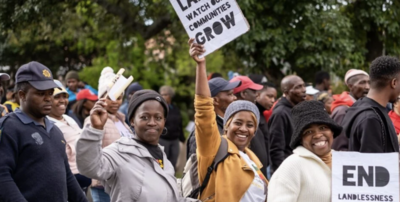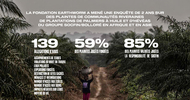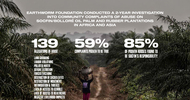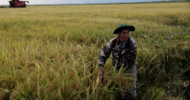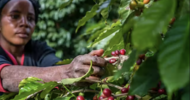Tasmanian farmland is seeing a hedge-fund buying spree—locals fear climate investors not tourists
by Justin Brown
I was half a world away from home, perched on the eighth-floor balcony of my Singapore apartment, when the idea crystalised. If climate volatility really is the new normal, I told myself, I need more than bank balances and air-conditioned comfort—I need ground to stand on. Real ground. Dirt that soaks up rain, pasture that feeds stock, a ridge line I can watch the weather roll over. My Australian passport gives me an open door to buy land back home, and a neat flight time from Changi keeps it within reach. So, late at night, while the city hummed beneath me, I opened the laptop and typed “Tasmanian grazing property for sale” into the search bar. By dawn, the search had morphed into something stranger: every prime parcel I liked already belonged—or was about to belong—to a fund manager.
The best example was a 700-hectare slice of the historic Woolnorth estate on far-north-west Cape Grim. I thought I’d unearthed a hidden gem; instead, I had stumbled into a headline. Melbourne-based Prime Dairy, the ag-arm of Prime Value Asset Management, paid A$15 million for that block in March last year, taking its southern dairy portfolio to roughly 5,000 hectares spread across Tasmania and Victoria. ABC Rural called it “a good deal”—and it was, if you measure value by litres of milk and internal rates of return. But to a would-be family buyer the deal felt like the gate slamming shut just as I arrived at the fence.
Prime Dairy is not alone. In October 2023 a heavyweight pension-fund trio—UniSuper, the UK’s Pension Protection Fund and Dutch giant APG—teamed up to acquire Forico, Tasmania’s largest private forest manager, and the 170,000-hectare hardwood estate it stewards. The sellers at New Forests put the price tag near A$900 million. Forico’s own press note billed the consortium as “long-term guardians of natural capital”; the numbers tell a simpler story of funds rotating out of one managed vehicle into an even larger pool of patient money. Forico’s release summed up the logic: institutional capital wants carbon sinks, rainfall insurance and stable, export-ready biomass. Those assets are suddenly scarce, and Tasmania has them in spades.
The deeper I dug, the more the pattern repeated. Chinese-controlled Van Dairy, once the country’s biggest single dairy operation, is being dismantled block by block and vacuumed up by domestic funds; Prime Dairy took the latest bite, but Macquarie, Laguna Bay and Warakirri have all circled earlier parcels. Forestry parcels change hands between specialist timber funds at values that make small farmers blink. Water-rich mixed farms in the state’s north-west advertise expressions-of-interest, and the competition often ends in sealed-bid tenders where town lawyers represent buyers with LinkedIn profiles rather than gumboots.
None of that automatically makes the transaction sinister; money chasing returns is mostly what money does. What jarred was the speed. I rang an old uni friend now dairy-farming near Smithton. He laughed when I floated a vague plan to buy 200 hectares for a regenerative project. “Mate, if it’s flat enough to run a centre-pivot, a fund will out-bid you. They’re paying on a ten-year horizon and a big carbon-credit upside. You and I price on the next five dry summers.” His anecdote meshed with numbers from CoreLogic’s rural-property data set: prime Tasmanian dairy land averaged A$7,000 a hectare five years ago; last year some blocks cracked A$25,000.
The local disquiet isn’t just about price. An excellent ABC Landline report in 2021 quoted Circular Head farmer Ryan Langley grimly counting “only nine family farms left” in a district once dotted with dozens. His wife, Kate, called corporate consolidation “the end of the dream” for young farming families. That was four seasons and several headline sales ago. I rang the Langleys for an update and heard resignation laced with new frustration: wages are up thanks to labour shortages, but land rent is up further; neighbours sell to funds because those buyers waive finance clauses and wire deposits in hours. “It’s like competing with a different species,” Ryan said. If you want an on-the-ground definition of an asset bubble, ask someone who lost the auction when the bubble was still inflating.
Why has Tasmania become the board-room favourite? Part of the answer lies in a peer-reviewed 2021 study out of Anglia Ruskin University’s Global Sustainability Institute. The paper assessed which regions could best endure a civilisation-level “de-complexification” and flagged New Zealand, Iceland, Ireland—and Tasmania—as top nodes of resilience. The Guardian’s write-up of the research went viral, half serious, half doomsday click-bait, but the investment community read it with colder eyes. Here was academic cover for what portfolio managers already whispered: temperate islands with rain belts and sparse populations make excellent lifeboats if climate models tilt from “bad” to “worse”.
Add the emerging market for Australian Carbon Credit Units—forest-rich estates like Forico’s can stockpile ACCUs and sell them to airlines and miners looking for offsets—and you get a potent cocktail: ESG gold-rush meets doomsday prep. Funds pitch those themes to trustees; capital flows accordingly. In a world where money hunts yield beyond zero-interest bonds, Tasmanian dirt looks thrillingly tangible.
I can’t claim moral high ground here. My own itch to own a patch of land is driven by the same weather charts and supply-chain anxieties. Yet when I flew down in February and drove the Bass Highway scouting listings, the dissonance was physical. Rolling green, air crisp with salt; every second gate carried either a corporate logo or an agent’s “under offer” sign. Locals I met at the Smithton bakery were polite but wary. One older bloke asked if I was “another mainland suit buying cows for the tax write-off”. I told him I lived in Singapore and wanted a long-term base. He snorted: “So you’re the expat version.” He offered advice anyway: look inland, away from the high-rainfall coast. Funds want scale and water security; hill country still trades on a multiple farmers can stomach.
Back in Hobart I checked the Foreign Investment Review Board guidelines: as an Australian citizen I can buy without FIRB approval, but if I structure through my Singapore company the deal crosses a reporting threshold. Funds, meanwhile, often buy through Australian registered trusts seeded with Cayman or Delaware money, skirting the bureaucratic lag rookie buyers face. That asymmetry compounds on settlement day. One agent told me a local grazier bid A$7.2 million for a 300-hectare block; a Sydney-based boutique fund swept in at A$8 million with no finance clause and five-day due diligence. The grazier was still wrangling bank valuations when the title changed hands.
The pattern isn’t unique to Tasmania—Queensland’s Western Downs and Victoria’s western districts have their own waves of institutional capital—but the island’s compact land mass magnifies every sale. When a 170,000-hectare forestry estate changes hands, it shifts the ownership dial by whole percentage points of the state’s private land. When a fund knits four dairy blocks into one 10,000-cow platform, milk processors pivot supply contracts, local contractors grow or fold accordingly, and school enrolments wobble if family farms exit. This is scale economics accelerated by climate anxiety.
So where does that leave someone like me, with ambitions humbler than Prime Dairy’s but deeper than a holiday shack? I ran the numbers on three options:
First, out-bid the money men—pay the new normal and hope long-term asset inflation beats the yield skim I give up. That means A$3 million for 120 hectares of rolling country in the Mersey Valley, plus another half-million to fence, plant shelter belts and convert the old herringbone dairy to a cool-room and workshop. Viable, but only if my digital business keeps throwing off cash and buyers keep paying more for regen-raised beef in twenty years.
Second, pivot south-mainland. Tumut in NSW has irrigation water and proximity to Canberra markets, but bush-fires turn river-flats to blacktop every decade. South Gippsland tempted me until a friend there sent photos of last winter’s floodwater lapping veranda boards. Climate risk isn’t something you dodge; you choose your flavour—fire, drought, flood—and pay the actuarial premium.
Third, wait. Keep cash liquid in an offset account, watch bond yields creep higher, and hope high interest rates eventually spook over-leveraged funds. Maybe a few premium holdings will leak back onto the open market at 2021 prices. The trouble with “wait” is psychological: the more headlines scream about Tasmania’s resilience, the more FOMO tightens its grip. Patience is a virtue until it becomes paralysis.
Before leaving the island I drove north to Stanley and climbed The Nut, the volcanic plug that crowns the fishing town. From the look-out you can trace beef paddocks north to Woolnorth and the Roaring Forties beyond. Wind turbines slice the air; black-and-white Friesians graze the ridges; Cape Grim’s air-quality station blinks on the horizon, proving the place really does bottle the world’s cleanest air. Standing there I felt the magnetism that institutional investors convert into spreadsheets. It’s hard to price serenity, but once you taste it, spreadsheets follow.
Two days later, back in Singapore, I re-opened the Woolnorth listing out of habit. The page now read “SOLD—contracts exchanged”. My cursor hovered over the photo and, for a flash, the digital image felt heavier than the real paddock ever could. Perhaps that is what climate capital does: it converts future fears into present-day liquidity, then buys the view before the rest of us decide whether the fear is rational.
That leaves ordinary buyers—expat, local or dream-struck millennial—negotiating against an opponent that never sleeps, never ages, never needs a home, and values land less for the grass it grows than for the carbon it stores or the optionality it carries. We can compete on price or creativity. I lean toward creativity: smaller, steeper, mosaic parcels that funds deem too fiddly; short-term leasebacks to neighbours; agro-forestry strips that qualify for ACCUs without locking the gate on food production. None of those gambits will roll back the institutional tide, but they might carve humane eddies in its flow.
The bigger question—one Tasmania must answer soon—is how much of its food-bowl can be outsourced to balance sheets before community cohesion snaps. The state government quietly adjusted stamp-duty concessions last year to attract capital; opposition MPs now talk about protecting “strategic agricultural assets”. Farmers’ lobbyists push for a corporate land-tax surcharge; treasury boffins recoil at the paperwork. Meanwhile milk tankers and log trucks roll on, the tangible evidence of ownership changes that most tourists will never notice.
I notice, though. So do the Langleys, and the Smithton butcher who says fewer family farms means fewer weekend sausage orders, and the school principal who worries about shrinking class sizes. If the price of resilience is the transfer of land from farmers to financial engineers, what exactly are we resilient for? It’s a question investors rarely pencil into discounted-cash-flow worksheets, yet it shadows every conversation once you leave the city.


